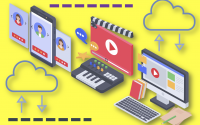
What’s Next for Remote Learning?
Colleges spent millions of dollars facilitating the pivot from face-to-face to remote instruction last spring. Administrators who oversee online learning don’t want that investment to go to waste. Inside Higher Ed
Premier Portal for Professionals Since 1995, Covering Technology-Based Education

Colleges spent millions of dollars facilitating the pivot from face-to-face to remote instruction last spring. Administrators who oversee online learning don’t want that investment to go to waste. Inside Higher Ed

Indiana University has released preliminary findings from a survey of undergraduates and instructors across its all of its campuses, examining their experiences of the transition to remote instruction this past spring. The research was conducted by the eLearning Research and Practice Lab, a unit within IU’s Pervasive Technology Institute, as part of the “Mega-Study of […]

The currently available measures of online teaching effectiveness (OTE) have several flaws, including a lack of psychometric rigor, high costs, and reliance on the construct of traditional on-the-ground teaching effectiveness as opposed to the unique features of OTE (Blackman, Pedersen, March, Reyes-Fournier, & Cumella, 2019). Therefore, the present research sought to establish a psychometrically sound […]

Young people need the right resources at their disposal to navigate uncertain times and to pursue their evolving interests and passions. All too often, however, a critical resource in the opportunity equation repeatedly goes unmeasured: students’ social capital. Social capital describes students’ access to, and ability to mobilize, relationships that help them further their potential […]

This paper reports two related studies on the role of student work, university connectedness, and taking online courses on college student academic success. In study 1, it was found that differences in GPA between students taking varying numbers of courses online is predicted by the number of hours students are working and not course format. It […]

The American fall college semester is still a work in progress. While some institutions once planned a partial or full reopening of campus, recent coronavirus outbreaks have changed that calculus. Many students are being told to prepare for another virtual semester. Many educators are growing more worried about the long-term learning gaps that may crop […]

Formative feedback from students can help college instructors improve their online teaching practices – especially instructors who are new to online teaching. Prior research indicates that mid-semester formative evaluations of college teaching are a promising, low-cost solution to providing online instructors with in-the-moment feedback. However, existing instruments suffer from issues of validity and bias, and […]

A public data analysis shows many higher-ed leaders are considering a range of scenarios, while many faculty are planning for online learning eCampus News

Educators and students in schools across the United States have faced sweeping, unprecedented changes to teaching and learning because of the coronavirus disease 2019 (COVID-19) pandemic, which shuttered school buildings in spring 2020. This Data Note presents selected results on several aspects of schooling, including both teachers’ and principals’ perspectives, and it examines inequities in […]

The last two decades have seen a steady increase in the number of online courses in higher education. This survey-based study examines student readiness for online learning in 2018, through the dimensions of importance and confidence as measures of readiness. An instrument with four subscales of competencies (online student attributes, time management, communication, and technical) […]